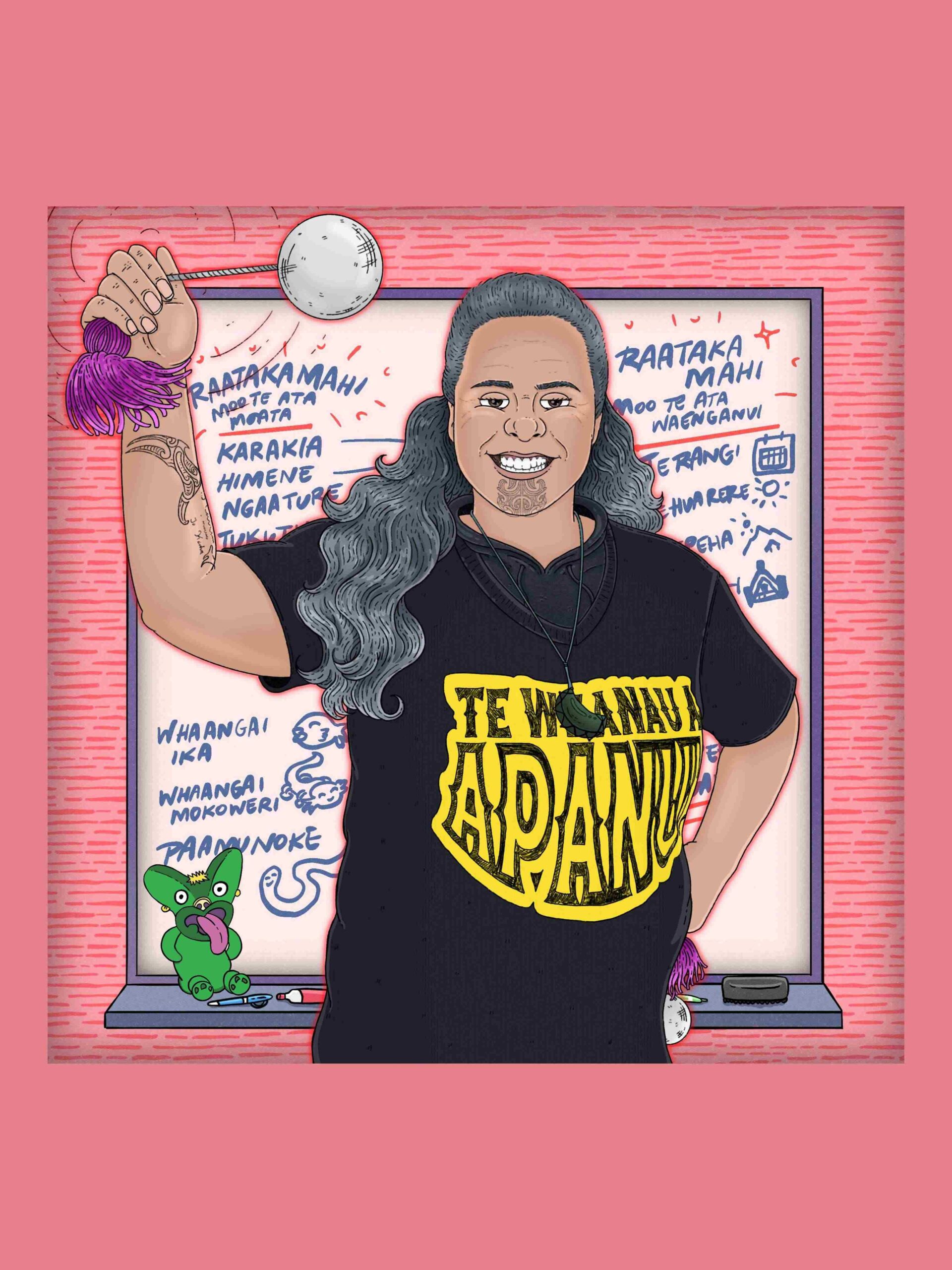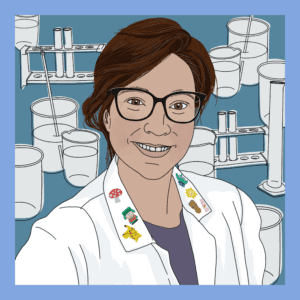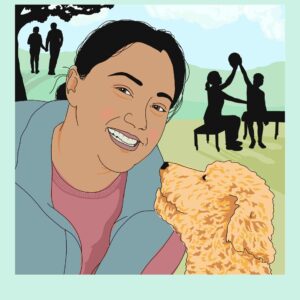Mana Kaiako!! Happy teachers’ day!!
We’re celebrating Teachers’ Day here in Aotearoa by kicking off a new series profiling our members, starting with teachers first.
‘A Day in the Life’ will highlight the incredible mahi done by our NZEI Te Riu Roa members. It will show the reality of our educators who care for the tamariki of Aotearoa, and celebrate all the parts that make us a diverse and inspiring bunch!
If you would like to see a colleague or yourself in this series, please get in touch with us at ako@nzei.org.nz.
Q1: Tell us about yourself?
Kia Ora e te Iwi
Ki te taha o tooku Paapaa
Ko Maungaroa te Maunga
Ko Kereu te Awa
Ko Kaiaio te hapu
Ko Te Whanau A Apanui Te Iwi
Ko Te Rata McRoberts tooku Paapaa
Ki te taha o Tooku Maamaa
Ko Maungakiekie te Maunga
Ko Manukau te Moana
Ko Ingarangi te Iwi
Ko Margaret McRoberts tooku Maamaa
Otira
I tipu ake au ki Ngaruawahia
Ko Hakarimata te maunga ki mua i tooku whare
Ko te Taniwha Tuheitia ki muri i tooku whare
Ko Ngaruawahia teetahi o ooku turangawaewae, nā te hāpori o te taone nei ahau i poipoi, i whakatupu
Ko Clifford, ko Shane raatou ko Trevor ooku tuungane, Ko au te pootiki o tooku whaanau
Ko Dane raaua Ko Kaiaio aaku tama
Ko Bonnie taaku hunaonga
Ko Arden Marama taaku mokopuna tuatahi
Ko Lisa Marama McRoberts ahau
Kei Te Puna Reo o Te Koohao Health e mahi ana
Ko au te Kaiako Matua o Te Puna Reo o Te Koohao
Ehara taku toa I te toa takitahi,
Engari he toa takitini
My strength is not that of an individual but that of the collective
Q2: Who was your favourite teacher or biggest mentor/supporter growing up?
No one stands out for me in Primary or High School, it’s not until about the age of 35, while doing my Bachelor of Primary School Teaching through Te Wananga o Aotearoa in Kirikiriroa, that teachers came into my life. They saw me and my potential before even I realised my potential. In particular, Whaea Aroha Lemeke and Whaea Areta Kahu — Kaiako who would awaken the ihi within and support it through patience, understanding, love and knowledge.
Through my whole life, I have always had the support of my whaanau, no matter the adventure I wanted to embark on. It was through my studies that I really needed and got the support from them. Even to this day, my whaanau are at my side through thick or thin.
Q3: What do teachers do all day?
I wake up between 5.30am and 6am to take my dogs for a walk. Then it’s time to feed the chickens, cat and the dogs. Cuppa time, making lunch, while trying to negotiate the kitchen and bathroom with other whaanau before I jump in the shower to get ready for my day’s mahi.
Then my workday will either start at 7.30am or 9am, depending on whether I’m on an early or late shift.
If on the early shift, we get a quick 15-minute window to whakarite te whare/get the whare ready before it’s time to meet and greet the whaanau and tamariki for the day.
We also have a breakfast club in the morning so that tamariki can have a kai — because just like some adults, not all tamariki are ready to eat first thing in the morning.
At 8.45am, our 3- to 5-year-olds cross over to the Puna Reo. In the Puna Reo, we speak Te Reo Maaori I ngaa waa katoa/all the time. This supports the tamariki that will be heading off to Kura Kaupapa or Whare Kura.
There is a lot happening at the Puna Reo: we have doctors, lawyers, hairdressers, artists, athletes, musicians, singers, chiefs, gardeners, digger drivers, wrestlers, stunt drivers and drama queens … any career you can think of! Our tamariki will test the waters for their future careers at Te Puna Reo o Te Koohao.
For these careers to surface, our kaiako make sure to recognise the interests of our tamariki through planning and providing opportunities and activities around these interests or kaupapa,
Our chefs love cooking alongside our kaiako whether it be soup, cupcakes, biscuits or pizza, you can hear them saying “Pirangi au.” While some tamariki would have you sitting there all day reading if it were up to them.
Waa whaariki is a great time to introduce new waiata to the tamariki and kaiako. You can tell a waiata is a hit because you will hear tamariki singing it throughout their play or whaanau will hear it from their tamaiti at home.
Our day might involve haerenga. Just recently, we attended Te Rito Maioha 60th Birthday Celebration at Te Whare Taonga o Waikato. We attend poowhiri when our tamariki start at kura and provide poowhiri when manuwhiri are coming. This year, a roopu attended the Koroneihana in Ngaruawahia. We try to get to the ngahere as much as possible, as well as walking out our front door to attend local community events at the Enderley Community Centre and be part of the bigger community of Te Koohao Health. We love haerenga but any kaiako would know they come with paperwork.
My day finishes at 4pm on an early shift and 5:30pm on a late shift. Once a fortnight we get together for two and a half hours to have our full staff hui (as well as ruuma hui).
I’m lucky that I have a team that brings a wealth of Te Ao Maaori knowledge to the Puna Reo and Koohunghunga to share with our mokopuna — through waiata, karakia, karanga, pao, waiata a ringa, keemu, koorero, pakiwaitara and their personal experiences.
Then in my spare time …
I love the simple life.
Hanging with whaanau, friends and my dog. Eating. And going on road trips.
I must say being in the union has also meant some fun things to do, and I have been on a few road trips to get to Miro Maaori Kaupapa.
Q4: People think my job is …
a babysitting service, or tamariki only go there to play and babies to sleep.
It reminds me of a saying I heard somewhere ….
Good to see you
Wouldn’t want to be you.
Not everyone’s dream job is in an environment where organised chaos is allowed and promoted.
But it’s actually..
The most important part of a child’s education. Most parents save their money so they can support their children in their tertiary education but the early years of our tamariki are the most important part of their educational journey. This is where they start learning dispositions such as problem-solving, determination, persistency, curiosity, aroha, manaaki, tiaki, pono me te tika. It’s in their early years of life that brain development is the most crucial. We provide activities that support this such as crossing the mid-line through kapa haka, mahi a ringa, poi, obstacle courses and keemu.
Another important part of our jobs is to support our tamariki to regulate their emotions and feelings. They learn to use their words to communicate instead of their hands and or teeth. There is no one-step process for providing positive guidance for tamariki, rather, this learning is best supported with whaanau involvement so we can work collaboratively to support the growth and development of the tamaiti.
Q5: The favourite part of my day?
I love being with the tamariki and playing alongside them and seeing them grow and develop. I love the connections I make with the tamariki, whaanau and hoa mahi.
I love that I get to go to work to learn Te Reo Maaori me oona tikanga.
For 8 hours a day I am immersed in Te Reo Maaori and am looking forward to one day Te Reo Maaori not only being my first language at mahi but at home alongside my whaanau too.
Kotahi anoo te koohao o te ngira e kuhuna ai
Te Miro Ma, Te Miro Pango, Te Miro Whero.
There is but one eye of the needle through
which the white, red and black threads must pass.




